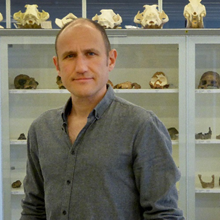Emiliano Bruner, researcher in Hominid Paleoneurobiology at the National Research Center for Human Evolution in Burgos (Spain).

Astract
The human parietal cortex is extremely complex and specialized, when compared with other primates. Differences are so noticeable that there are still many issues concerning homology, in terms of structure and function, between human and non-human parietal areas. Surprisingly, these differences are passed largely unnoticed in evolutionary neuroanatomy and anthropology, until recently. Humans display enlarged and diversified cortical regions in both superior and inferior parietal lobules, probably associated with specializations in visuospatial functions, attention, tool-use, social relationships and language. The study of brain morphology in extinct species (paleoneurology) suggests that, when dealing with hominids, macroscopic changes in the parietal cortex can be observed in Neandertals and, more prominently, in modern humans. Such anatomical variations approximately match evidence of cultural and behavioural changes, including a substantial increase of technological and social complexity, and specialized visuospatial skills (haptic capability, projectile weapons, and arts). The evolution of the parietal cortex can be hence associated with specializations of the frontal-parietal system integrating brain, body and technology, and leading to profound cognitive changes embedding space, time, and body perception. All these features are also crucial to self-consciousness, and point at potentialities and limitations of our own species.
References
Bruner, E., & Colom, R. 2022. Can a Neandertal meditate? An evolutionary view of attention as a core component of general intelligence. Intelligence, 93, 101668.
Bruner, E., Battaglia-Mayer, A. & Caminiti, R. 2022. The parietal lobe evolution and the emergence of material culture in the human genus. Brain. Struct. Funct. doi.org/10.1007/s00429-022-02487-w.
Bruner E. 2021. Evolving human brains: paleoneurology and the fate of Middle Pleistocene. J. Archaeol. Method. Theory 28: 76-94.
Bruner E. 2019. Human paleoneurology: shaping cortical evolution in fossil hominids. J. Comp. Neurol. 527: 1753-1765.
Bruner E. & Gleeson B.T. 2019. Body cognition and self-domestication in human evolution. Front. Psychol. 10: 1111.
Bio
Emiliano Bruner, researcher in Hominid
Centro Nacional de Investigación sobre la Evolución Humana
Paseo Sierra de Atapuerca 3; 09002 Burgos (España)
https://paleoneurology.wordpress.com/
CRNL - CH Le Vinatier - Bâtiment 462 Neurocampus Michel Jouvet - Amphithéâtre Neurocampus, 95 Boulevard Pinel, Bron











